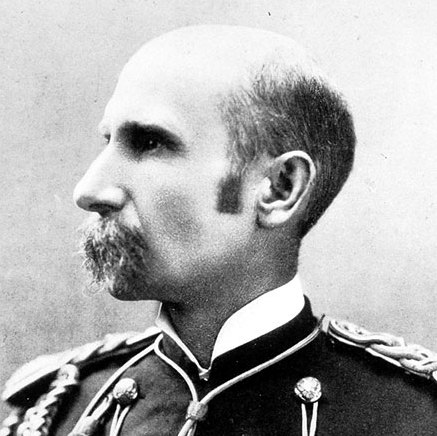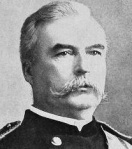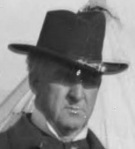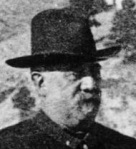I fear to leave this vicinity in pursuit of Big Foot as he might turn north and commit depredations.
–Maj. Gen. N. A. Miles
This day 125 years ago… the hunt for Big Foot began in earnest as forces were directed to block or intercept the Miniconjou band. (click to open Hunting for Big Foot homepage)
The time displayed, e.g. (9:30 a.m.), at the beginning of each message reflects when that information was sent from or received at General Brooke’s headquarters, unless otherwise indicated. Most of the messages were transmitted via telegraph. Those messages that were delivered by other means such as couriers or heliograph are so annotated in parenthesis at the end of each respective message. Hover the mouse over the names displayed in Red to display the full identity of the individual mentioned. Bold Red will also indicate location of the individual. Blue underlined texts are hyperlinks to other pages or cites. Click on photos of individuals to see an enlarged version of the source photograph in a new tab. Similarly, clicking on maps will open a new tab with an enlarged view of each map that can be zoomed in for greater detail.
Wednesday, Dec. 24, 1890.

Carr to Miles (sent 10 a.m.): Respectfully forwarded [Sumner’s message regarding Big Foot’s escape] to General Miles. I am starting with all troops here to cut the trail. One troop out patrolling and four troops go with me. {1061}
Ruger to Brooke: Colonel Sumner, who reported on the twenty-first the surrender of Big Foot with all his people and others, at this village, some thirty young men from Cherry creek and thirty-eight Sitting Bull refugees, latter mostly women and children, reports, dated yesterday, that Big Foot had slipped off and moved south with ponies and lodge poles, no wagons; that he has notified Colonel Carr, the date not stated, number going with Big Foot, nor whether any women and children. I directed Sumner to pursue, but, of course, much time is lost. {497}
Miles to Brooke (11:55 a.m.): I regret exceedingly to say that Big Foot has eluded Sumner and is now going south in light order on ponies. Will probably join those in the Bad Lands. Carr has been notified to endeavor to intercept them. If a command were to move quickly from Pine Ridge a little north east and thence down Porcupine or in that vicinity, it might possibly intercept them. They need not disturb any that may be coming from the Bad Lands. We must now close up all possible avenues of escape, shorten the line and enclose them. Big Foot has one hundred men. {498}

Roe to Henry: The Commanding General directs that you move at once with your command, 10 scouts, pack train and two mountain Hotchkiss guns down Wounded Knee creek and across on the road to road running to the mouth of Rapid creek and endeavor to intercept any Indians coming from the north. You will probably find them trying to enter the Bad Lands from trail on Bad Water or Cottonwood creeks. Copy of telegram from Division Commander on this subject enclosed. (letter) {503}
Brooke to Miles (12:45 p.m.): I send Major Henry with his battalion of cavalry to the road running from Porcupine across to Rapid creek and cover the entrances to the Bad Lands from the east. He will move at once, though I am pretty sure Big Foot’s party will be in the Bad Lands before he can possibly reach the point he is to go to. {499}
Miles to Brooke (2:50 p.m.): The line is entirely too long, and if those Indians in the Bad Lands do not surrender at once they will endeavor to break through the line and escape. I have no idea they intend to remain in the Bad Lands and the line can be shortened by a night march from all points and we might possibly enclose them. The greatest danger is their breaking through along the line of Cheyenne river and going south or north of the Black Hills. Shafter’s regiment could be put on train and moved to any point between Oelrichs for any service required of it. Sanford’s command can be moved up by train to Meade in case they should escape. I regret exceedingly these Indians escaping from Sumner. It is most unfortunate just at this time. His orders were positive and he reported that he had them, but he was deceived. Possibly you may receive more favorable news from your front, but we should be prepared for serious work immediately. What available force will you have after leaving necessary forces to hold and control at Rosebud and Pine Ridge? {502}
Miles to Brooke (2:55 p.m.): Sumner reports camp near Big Foot’s village December 23rd, ten p.m. Big Foot sent word that he would go to Bennett to-morrow. Marched near his village and found he had started south in light order with ponies, lodge poles, no wagons. I fear to leave this vicinity in pursuit of Big Foot as he might turn north and commit depredations. Carr was notified soon after daylight to push a command eastward to intercept. Your prompt action in sending Henry’s command may be effective. Big Foot may possibly have about one hundred and thirty men, 330 people. {501}

Roe to Henry: Big Foot left his camp last night with ponies and lodge poles, no wagons. He started south. Sumner thinks he might turn north. Carr was ordered soon after daylight to post a command eastward and try to intercept him. There may be about 130 men, 330 people in all. This has reached here after you left and is sent after you. If you can reach the trail going in from Cottonwood you may be able to intercept him. At the same time look carefully to the eastward of the road from Porcupine north. Should you find he has gone in, establish yourself so you can keep him there. Be very careful to avoid any complications with the Indians sent out from here, if at all possible. (by courier) {504}
Brooke to Miles (3:35 p.m.): Do you wish Shafter moved at once to Oelrichs? I have ordered him to put his regiment on board the train now at Valentine and await orders. I can send Forsyth with two battalions of his regiment to close the line at any time. This constitutes all of my available force here and at Rosebud. I am holding the two troops of cavalry at Rosebud for any service they may be needed for to the north or elsewhere, but they would hardly be in time now for this. I expect to hear from the Bad Lands this evening and if Big Foot has not gotten there before I would not be at all surprised to hear that the Indians there were coming in. If they should break through to south of Black Hills I can send cavalry from Rosebud to railroad and send it west to Crawford and then north on B & M road to any point. The cavalry here could go that way also, at least a battalion of it. Sanford should know of any move in that direction, as I ordered him to patrol to north east and south east. I am now all equipped for anything at very short notice. It might be well to keep some cavalry here in addition to the infantry. I wish to say that the Indians in the Bad Lands disclaim any intention to fight and are only preparing for defense. This is what all my information impresses on me. If Big Foot gets there this purpose may change. I will hope they will start in to-morrow. Henry will be across the only way of getting in before daylight to-morrow. I have sent word to the friendly Indians that these troops are not going against them. There is a question in this which I would ask you to answer soon as possible. {506}
Brooke to Ruger (5:40 p.m): I sent Major Henry to the road between Porcupine and Rapid Creek this afternoon to intercept Big Foot’s party. He will be across the only trails from that direction early to-morrow. I am sorry this has occurred as it will quite likely defeat the effort now being made to bring in the Indians in the Bad Lands. {512}
Brooke to Miles (5:50 p.m.): Do you not think it probable that Big Foot has gone to Cheyenne agency? It would appear to me quite likely that he would try to hide amongst his own people. If he has gone in the direction of the Bad Lands and Carr sends a few troops south on the road from mouth of Rapid Creek to meet Henry I think the junction would be prevented. {508}
Brooke to Miles (6:15 p.m.): The reports of all Indians coming from the Bad Lands coincide in the expression that they are all crazy on the matter of the Messiah. That they do not want to fight the white man and so forth. A crazy white man [Hopkins] came here two days ago and proclaimed himself the son of God. The Indians who did not see him were quite excited. Those who did see him said he was crazy. {513}
Brooke to Miles (6:30 p.m.): You speak too long a line. Why not make it on the road from White Clay to French creek and along White river to road from Wounded Knee to Rapid creek? This would enclose the Indians and leave troops in large enough bodies to detach enough for pursuit if they should break through, which I don’t think probable. The Indians in the Bad Lands have done the thing you thought improbable, from all I can learn they have placed their camp in that part of the table on the north which is connectedly a narrow neck to the main table. The top of the whole table is a rolling, level plain with a few places for water. If any Indian escapes it will be on foot only. I would recommend an attack as outlined in my letter to Carr. I think cavalry can be used dismounted at all points. The distance precludes a sudden movement of infantry. {514}
Miles to Brooke (7:30 p.m.): Should Big Foot turn east and go to his agency that would be very gratifying news, but his action does not indicate it. How would it do to have the First Infantry stopped near Oelrichs and have Sanford take the same train and move up to Fairburn? There is plenty of infantry but very little cavalry. You are more familiar than I am with that section of country about Oelrichs and know the chances of their escape in that direction. {509}
Brooke to Miles (10:30 p.m.): Standing Bear, one of the party that went to the Bad Lands, returned this evening. This Indian is one of the most progressive here. He tells me that many of the people there are crazed by the strange frenzy which prevails, that they court death, that they prefer to die, and goes through the story you know of the Messiah craze. That there are many who wish to come in who cannot get away, but he thinks those of the party still there will be able to bring in a great many. The nature of the ground is what I have already described to you and the number of fighting men was one hundred and nine and about ten old men. There might be a few more or a few less, but he thought he counted them all, and that he counted one hundred and thirty guns and pistols. The rest of the party, numbering over one hundred, will be in to-morrow with such as they can bring with them. His belief is that those who stay will be found there if the troops go out. I have questioned this man closely and am entirely satisfied that a movement such as I indicated in my letter to Carr will make a finish of the matter in a very short time. The road to the west of the table land being occupied would make the escape of any improbable. I have ordered Shafter to Fairburn. {516}
Tomorrow, Christmas day, the hunt continues.
(click to open Hunting for Big Foot homepage)
Source: John R. Brooke, Sioux Campaign 1890-91, vols. 1 and 2 (Philadelphia: Historical Society of Pennsylvania, 1919). These documents were typed and certified as true copies by 1st Lieut. James T. Dean who served as aide-de-camp to General Brooke from February 1893 to May 1895. These original certified copies appear to have been bound into two volumes and an index likely by Lieut. Dean during that same time frame. A label in the front of each volume indicates that they were presented by General Brooke to the Historical Society of Pennsylvania on 21 May 1919. The messages were not bound in chronological sequence, but rather grouped by similar material. The messages presented here have been reordered chronologically and represent only a portion of all the documents. Numbers inside the braces ‘{666}’ at the end of each message denote respective page numbers from the bound volumes. A select few of these documents–145 of over 1,080 pages–are also available online from the Historical Society of Pennsylvania under the title, “Correspondence, Sioux Campaign (vol. 2),” (http://digitallibrary.hsp.org/index.php/Detail/Object/Show/object_id/2392) accessed 8 Sep 2015. Maps and insets are from William F. Kelley, Pine Ridge 1890: An Eye Witness Account of the Events Surrounding the Fighting at Wounded Knee, edited and compiled by Alexander Kelley & Pierre Bovis (San Francisco: Pierre Bovis, 1971), fold out map attached to back of book.
Citation for this article: Samuel L. Russell, “Hunting for Big Foot, part 2: 24 December 1890,” Army at Wounded Knee (Carlisle, PA: Russell Martial Research, 2015-2016, http://wp.me/p3NoJy-P8) posted 24 Dec 2015, accessed date __________.








Today, I came across your blog while researching Frances M.A. Roe, the wife of Lieutenant Fayette Washington Roe (Lt. Roe was the son of RADM Francis Ashbury Roe and Eliza J. Snyder). Frances Roe is the author of “Army Letters from an Officer’s Wife, 1871-1888 (Appleton 1909). I noticed that your icon of Lt. Fayette Washington Roe is incorrect. According to the Nebraska Historical Society (NHS), the photograph taken at Pine Ridge during the Wounded Knee Massacre is of 3 uniformed men and one unidentified civilian wearing an overcoat and a knit cap. The Nebraska Historical Society identifies the 3 soldiers and possible surgeon civilian: General John R. Brooke and staff at Pine Ridge Reservation. Pictured left to right: Lieutenant Fayette Washington Roe, Third Infantry; Major Daniel W. Benham, Seventh Cavalry, General John R. Brooke; Major John M. Bacon, Seventh Cavalry, and an unidentified officer, believed to be a surgeon (see link: http://nebraskahistory.pastperfectonline.com/photo/5821CF89-20C0-4A5C-8D11-823262254537).
You may be interested in reviewing NHS’s “Wounded Knee Massacre” collection: RG2845 Wounded Knee Massacre. This collection includes photos of your great great grandfather General Samuel M. Whitside:
See link: http://nebraskahistory.pastperfectonline.com/photo/B7BD40B9-A22A-4DA8-A74E-123557948836
Catalog Number RG2845.PH000119-000068
Collection Name RG2845 Wounded Knee Massacre
Title Gathering the Dead
Description: 3 men standing in the foreground with a horse-drawn wagon carrying the dead bodies. In the background on a hill are more officers on horses. Caption says, “Gathering the dead. Two days after the battle at Wounded Knee. Col. Forsythe and General Whitside with escort near Pine Ridge Agency, S.D.” This caption errors, the photograph was made on 3 January 1891, not on the 2nd.
Indian War Views album page 35.
Same photograph as 13-10.
Date 1891/01/03
Photographer Trager, George
Place USA: South Dakota
Event Wounded Knee
Print size 7″ x 4.5″
People Foresyth, James William, 1835-1906
Whitside, Samuel M., 1839-1904
Classification Native American
Subjects Wounded Knee Massacre
Pine Ridge Agency
carts and wagons
officers
dead bodies
horses
My website on Frances M.A. Roe, (http://www.thescribblersinkwell.org), also includes a page about Lt. Fayette W. Roe including his photos: http://www.thescribblersinkwell.org/to-tell-the-truth-research-woes-or-is-that-roes-will-the-real-fayette-w-roe-please-stand-up/
LikeLiked by 1 person
Correction: Nebraska State Historical Society (NSHS)
LikeLike
Mary… After going back through my research, I am 99% certain that the officer identified by NSHS as being Lieut. Roe in the Brooke staff photograph is Lieut. Charles Marcellus Truitt. General Brooke had two aides-de-camp during the campaign, Roe and Truitt. If you look at a close up of that officer, he bares no resemblance to the other photographs you have posted of Roe, but looks strikingly like another known photograph of Truitt here: http://1-22infantry.org/commanders/truittpers.htm

LikeLike
Mary… Thank you very much for the corrections, as I strive to provide historically accurate information. I had cited the photo from the Denver Public library, which did not identify General Brooke’s officers in the photograph. I had misidentified Lieut. Roe in the photograph as Lieut. Truitt. I will correct my entries.
Thank you also for providing the other links, including to your site. I have read “Army Letters from an Officer’s Wife.” They provide a very unique, and seldom revealed perspective, of life in the frontier posts.
The caption, “3 men standing in the foreground with a horse-drawn wagon carrying the dead bodies. In the background on a hill are more officers on horses. Caption says, “Gathering the dead. Two days after the battle at Wounded Knee. Col. Forsythe and General Whitside with escort near Pine Ridge Agency, S.D.” This caption errors, the photograph was made on 3 January 1891, not on the 2nd.” The other error in the caption is the Colonel Forsyth did not accompany Major Whitside to the battleground. Whitside was indeed on the battlefield on 3 January. He wrote to his wife: “Monday, January 5th, ‘91. At midnight Friday, I received instructions to proceed at day light Saturday A.M. with a burial party to the battle ground of Wounded Knee for the purpose of assisting in making a complete map of the ground locating thereon the exact position the Troops occupied from the commencement to the end of the battle. I obeyed the order literally and only returned to my camp here last evening at 8 o’clock pretty badly used up, but a good night’s rest was most refreshing and I am feeling very much improved this morning.”
Major Whitside’s campaign letters are posted here: https://armyatwoundedknee.com/2014/08/01/major-samuel-marmaduke-whitsides-campaign-letters/
and my article of the map maker who accompanied Whitside is posted here: https://armyatwoundedknee.com/2014/09/27/map-of-wounded-knee-and-its-maker-second-lieutenant-sydney-amos-cloman-1st-infantry-regiment/
Sincerely, COL Sam Russell
LikeLike
Good Afternoon Sam,
Thank you for your response(s) about the NSHS photograph in which you provide probable identification of the officer at the far left as Lt. Charles M. Truitt rather than Lieutenant Fayette Washington Roe, Third Infantry (http://nebraskahistory.pastperfectonline.com/photo/5821CF89-20C0-4A5C-8D11-823262254537), also citing the websites: Denver Public Library and Truitt’s bio at http://1-22infantry.org/commanders/truittpers.htm.
As an archival researcher, I too have also come across variances in historical provenance including online digital collections to actual hands on documentation at libraries and historical societies. And not surprisingly, I too have found errors and notified sites providing documentation when possible; particularly, with the online digital photo collections including the Library of Congress and the Denver Public Library (DPL).
While researching Captain Fayette Washington Roe, I had originally come across a photograph of an officer identified as “General Fayette W. Roe” at the DPL. I knew he never made the rank of “General” yet considered the possibility of a brevet General. As you read in my blog, I discovered in my research several photos of Lieutenant Colonel/Captain/Lt. Fayette W. Roe that did not match the photo at DPL’s online archival digital photograph collection. Through due diligence, I was able to identify the General as Major-General Charles Francis Roe who graduated in 1868 from USMA and not Captain Fayette W. Roe who graduated in 1871 from USMA.
Thus, in my recent quest to correctly identify the correct officer: Lt. Fayette W. Roe (or is it Lt. Charles M. Truitt), I contacted NSHS querying the photograph’s provenance. According to the NSHS Photograph Curator:
“As the second line of our online record indicates, we hold a photographic print (an albumen cabinet card ca. 1890 to be exact). According to Denver Public Library online record form, they hold the copy negative and a copy print (see the Type of Material line). DPL hold, however, holds many of Moreledge glass plate negatives of Wounded Knee. NSHS hold numerous original prints.
The identification was provided to the Nebraska State Historical Society in March 16, 1944 by Edgar F. Medray of Waukon, Iowa and Elmo Scott Watson of the Medill School of Journalism at Northwestern University. Medray was a representative of the New York Herald with General Brooke’s command during the Ghost Dance troubles of 1890-1891, the same time this image was taken.”
It seems more likely that Lt. Fayette W. Roe would be in this historic photograph due to his professional rank and close association with Brigadier General John R. Brooke who is often mentioned in Frances M.A. Roe’s book, “Army Letters From an Officer’s Wife, 1871-1888.” According to Robert M. Utely’s review of Roe’s book, “of the personalities she knew, these last she thinly disguised with altered names, but readers familiar with the frontier army will have no trouble recognizing Phillips as Penrose, Dickinson as Davidson, or Bourke as Brooke. Mrs. Roe thus becomes a major source for characterizations of particular frontier military figures). Also, in corroborating Roe’s close ties to General Brooke (Bourke), I have a photocopy of Brooke’s General Orders official notification of Lt Fayette W. Roe promotion to Captain in 1892: “Headquarters Department of the Platte, Omaha, Nebraska, July 27th, 1892. ….The Commanding General cordially congratulates Captain Roe on his well-deserved though long-delayed promotion and sincerely regrets that it necessarily entails departure from his military family. A pleasant official and personal acquaintance of twenty-one years, covering a varied service, including the intimate relations between an Adjutant and his Colonel and an Aide-de-Camp and his Commanding General, invites an expression of high regard for this faithful, efficient and conscientious officer…” As you stated, Lt. Charles M. Truitt was also part of Brooke’s staff; however, Truitt was promoted to 1st Lieutenant on April 24, 1886 and Roe became 1st Lieutenant March 15, 1883.
According to Roe’s obituary in the Forty-Eighth Annual Report of the Association Graduates of the United State Military Academy at West Point, NY (June 12, 1917):
“The incidents of Colonel Roe’s army life; his advancements in grade, and many changes of station, with numerous highly complimentary details for duty, are fully related in General Cullum’s Registry. For four years he was Aide-de-Camp to the General commanding the Department of the Platte, acting frequently as Adjutant-General, Judge-Advocate, Inspector of Small Arms and Engineer Officer. He was Adjutant-General of troops in the field at Pine Ridge, South Dakota, 1890-91, and of the concentrated troops of the Department of the Platte in the field at Camp Crook, Nebraska, in 1889; these two concentrations of regulars being the largest since the Civil War.”
If you have more information, I’d appreciate your help in clarifying who’s who! AS I know, nothing is written in stone until every stone has been overturned! One last thing, to clarify the Wounded Knee massacre photo of Major Samuel M. Whitside, NSHS will quickly respond to your provenance query. I wish you well in your excellent website and valuable historical research!
LikeLike
Utely’s quote ends at: frontier military figures)., the “)” is a typo
LikeLike